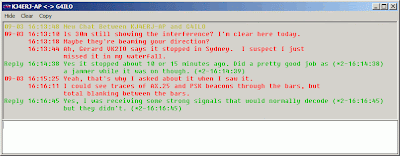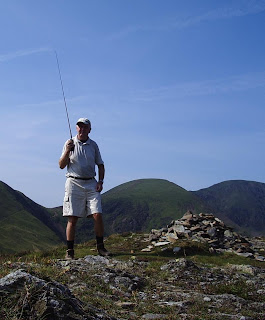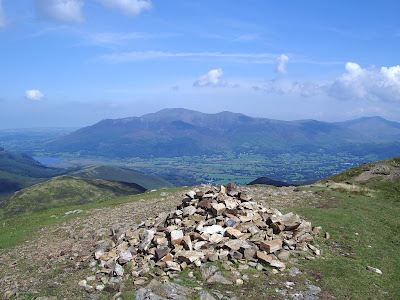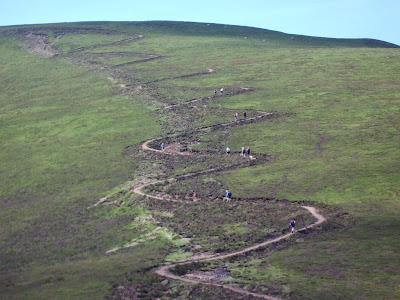Archive for the ‘aprs’ Category
 Barely making contact
Barely making contact
I was reflecting on what I wrote yesterday about the EchoLink app for Android and why I find it and similar developments disturbing. I thought it was because it made me uneasy having to face the fact that the internet and a cellphone appears to make ham radio redundant by allowing us to make the same contacts so much more easily without using the ham bands at all. Then I had a blinding revelation. Ham radio is not about making contacts. It is about not making contacts, or making them only with luck and some difficulty.
I almost stumbled across this truth a few months ago after I sold my first VX-8R to do APRS on a smartphone using Lynn KJ4ERJ’s excellent APRSISCE software. It worked far better than the 2m radio, allowing me to be tracked and exchange messages in places where there was no 2m signal. But I went back to using RF for precisely that reason. The smartphone didn’t provide the interest of allowing me to see how VHF RF propagates around the local terrain. The disappointment of not being tracked as I slogged up the mountain was balanced by my surprise when a beacon was gated from a location I wouldn’t have thought possible and the interest created in working out how it happened. There is also the technical challenge of finding ways to improve coverage and get a radio signal out of difficult locations, for which buying a smartphone is simply a cop-out.
When you look at other ham activities that remain popular or are even gaining in popularity it’s obvious that the interest is not in how easy it is to make contacts, but how hard. DXing isn’t about pressing the PTT and ticking another entity off the list a minute later, it’s about what you have to do – buy equipment, improve your antennas, learn about propagation, develop operating skills, be patient – in order to achieve it. People boast about the DX they’ve worked, but what keeps them interested in DXing is the places they haven’t worked and how hard it will be to work them. Dialling up a contact using an internet application has nothing to do with it.
Contesting isn’t popular because it’s easy to amass a winning score but because you need the best equipment, the best antennas and lots of skill to get even close. It isn’t meant to be a level playing field. That’s why many people dislike developments like reverse beacons and skimmers that take away some of the skill required.
QRP pursuits like WSPR or MEPT beaconing aren’t about making contacts at all, but just about seeing how far a whiff of RF can go. The excitement isn’t in being received by someone for the nth time, it’s that first barely detectable trace on the screen of someone or somewhere new that makes you punch the air (if QRPers go in for such QRO expressions of emotion.)
The thing about VHF FM activity is that for the most part it isn’t about the achievement of the contact at all. It’s just about being able to converse with people. When I was first licensed, before mobile phones and inclusive call packages, chatting on 2m FM was actually the best and certainly the cheapest way of keeping in contact with my local ham friends. But things have changed over the last 35 years and I haven’t been paying attention. I’m the dinosaur who wouldn’t disclose his mobile number to the radio club database because I felt that if someone wanted to talk to me about radio they could wait until they can contact me on the radio. But I suspect that everyone else has moved on. If they want to speak with one of their ham buddies they pick up the phone. Which may partly explain why the VHF bands these days are almost dead. Or even the development of D-Star, which provides some of the convenience of calling someone on the phone without totally abandoning use of the ham bands.
In only a handful of pursuits like SOTA and WOTA where the point is to make a contact direct using radio is 2m FM still used in what I would call a traditional manner. People will struggle to hear their signal report even if the activator is right down in the noise and get a feeling of having accomplished something when they are successful.
So EchoLink on a smartphone really doesn’t change anything. It already changed. Whether hams call one another on the phone using their phone number or their EchoLink node number really makes no difference. It has just been blinkered thinking on my part to have felt that if people hold ham radio licenses they ought to talk to each other using ham radio even if it isn’t the most convenient way of doing so.
 APRS Chat
APRS Chat
It has been a while since I wrote about the new APRS client for Windows and Windows Mobile being developed by Lynn, KJ4ERJ and known as APRSISCE/32 but it has been coming on apace with new versions being released almost every day. Many of the improvements probably won’t mean much to anyone who doesn’t know anything about APRS. But one of the more recent and quite revolutionary developments has been the chat window, which allows you to carry out a two-way text chat conversation with another APRS user.
Instead of the primitive edit box found in most APRS clients in which you would have to type your messages in 64-character chunks due to the limitations of APRS messaging you can now type just what you want and APRSISCE/32 will split it up and send it as separate messages transparently. It also takes care of ensuring the parts are displayed in the right order at the other end. You can also view the entire conversation in its own window – useful if you are having conversations with two or more people when you are tired late at night and lose track of what you are saying to whom!
You can chat with anyone, anywhere in the world. True, at the moment most of these conversations are being conveyed over the internet not RF, which will inevitably incur the complaints that “it’s not ham radio.” But they could just as easily use RF. The only problem is that for most of us an adequate APRS RF infrastructure to support worldwide messaging doesn’t exist. But the more people are attracted to the mode – and even the hobby – by cool developments like this, the more likely it is that an effective infrastructure will be built. In many parts of the world you could certainly link up across town on VHF like this.
Regular digital modes are fun. But is there any reason why the only way to have a contact is for two people to have sole occupancy of a frequency and one sends to the other, then the other replies back, repeat until finished, the way contacts have been made ever since Marconi first picked up a morse key?
 Hacking a USB GPS
Hacking a USB GPS
As regular readers will know, I’ve been playing about with APRS quite a lot in recent weeks and I’m starting to get the urge to build something APRS related. I’m planning to order one of the inexpensive FoxTrak kits, which lets you use a standard VHF FM radio to transmit position reports. To do that you also need a serial GPS and on searching eBay I became aware that serial GPSes seem to be rather more expensive than USB or even Bluetooth devices. This led me to wonder whether it would be possible to hack a USB GPS to use with a tracker like the FoxTrak. My investigations led me to this article by Primiano Tucci on GPS Hacking.
This post is basically an un-loseable bookmark to myself, since it will probably be a few weeks before I get around to working on this and by then I’ll have lost the article and never be able to find it again. But it might be of interest to someone else or provoke some interesting comments.
Although I’ll probably build the the FoxTrak as-is and test it with one of my 2m rigs I’m really interested in trying HF APRS on the move without having to buy an expensive TNC or lug a laptop around me so I can use AGWPE to generate the 300baud audio. So I’d also be interested to know whether anyone has modified the FoxTrak (or the TinyTrak which I believe is very similar) for the 300baud tones? I know the OpenTracker+ from Argent Data does 300baud “out of the box” but it’s quite a bit more expensive, enough more expensive to attract the punitive import fees that will almost double the price.
 Sound card packet modem
Sound card packet modem
Last night I spent a couple of hours trying a program that had been mentioned by Chris, G4HYG in the Cross Country Wireless Yahoo group called AX25-SCS. It is a sound card modem for 300baud and 1200baud packet which was written by Frank Perkins, WB5IPM for use with a now unsupported APRS program called APRS-SCS (nothing to do with the SCS that makes TNC hardware.) Chris claimed it works better than AGW Packet Engine at decoding HF APRS. It is also freeware. I had never heard of this program before despite quite a bit of time spent searching for packet sound card software. You can get it from the TAPR website, installation is simply a matter of unzipping it into a folder, and there is a .pdf file that tells you almost all you need to know to run it.
One of the things the documentation doesn’t tell you is that AX25-SCS uses the default Windows sound card. For testing, I had to make the sound card used by my Elecraft K3 the default. This is not convenient, as it robs my computer of the ability to play sound through the speakers (and risks broadcasting Windows sounds and web audio over the airwaves) so sadly I am unable to make permanent use of it.
The documentation also doesn’t advise you to select “Cancel APRS-SCS support” when you first run it. If you don’t, nothing will appear in the window until an APRS client connects to it, making you think that the program just isn’t working.
For HF use you need to select 300baud from the menu, as 1200baud is the default. You also need to select Enable SCS TX to allow transmission. It would be a bit of an annoyance that you have to do this every time you start the program as the settings are not remembered.
Once the receiver is tuned in – AX25-SCS uses the KAM standard 1600 / 1800Hz tones for HF – and the sound levels adjusted so that packets are being decoded, you can close and then restart the program this time choosing “Enable APRS-SCS support” from the initial dialog. After that, start APRSIS32 and create a KISS TNC RF port at address 127.0.0.1 port 4000. When APRSIS32 connects, the display should appear on the AX25-SCS window as it did before and this time any packets received should be displayed in APRSIS32 as well. Beacons and messages sent from APRSIS32 should result in audio being generated by the sound card modem for transmission.
For transmit, APRS-SCS requires the transceiver to use VOX. This is not a problem with my K3 which supports VOX via the rear audio connections and which allows the delay to be adjusted down to a very short interval, but it would make the program unusable with other transceivers like the FT-817 which don’t.
I tried running APRS-SCS and AGWPE Pro in parallel to see which was the better decoder but it was difficult to do a fair trial as APRS-SCS needs a lower level of audio input so the signal level was either too high for one program or too low for the other. As far as I could tell, APRS-SCS appeared more tolerant of off-frequency signals but less sensitive to weak ones than AGWPE Pro. This is also the verdict of Chris, G4HYG.
I would be willing to give APRS-SCS more of a try, but the inability to specify which sound card to use makes that impractical. It’s a pity that APRS-SCS is not open source so that someone could fix that and the other minor niggles, because it is a nice program that is quite easy to set up and use with APRSIS32.
 Mystery beacon
Mystery beacon
For the last three hours or so I’ve been driven mad by an APRS beacon on 2m that I can’t decode and which is not being gated to the internet by Richard MM1BHO’s gateway. The amount of activity on VHF APRS round here is so low that I normally leave the receiver audio on so that I can hear whether anyone is about. The signal I’m hearing is quite solid, obviously from a fixed station or a stationary mobile, and though it isn’t massively strong – just about making 1 bar on the Kenwood’s signal strength meter – it sounds fully quieting and as good as other signals I hear which are decoded.
I tried both wide and narrow FM modes and when that didn’t help I switched the antenna over to the FT-817 so I could try the AGWPE sound card decoder. I even tried plugging the antenna into the VX-8GR to see if that could decode it, but no joy. Listening to the sound of the beacon compared to the sound of my VX-8GR’s beacon, the one I can’t decode is quite a bit louder. I think it might be over-deviated.
So on the off-chance that someone trying APRS round here might read my blog, I thought I’d publish this posting. If it’s you, try turning the audio into the transmitter down and you might get gated.
 Another great cockup
Another great cockup
Another weekend of glorious weather. I decided to make an early start on Sunday and try a slightly more ambitious Wainwrights On The Air (WOTA) activation than normal. The plan was to walk over Barrow and Outerside and, if my legs still had enough energy left in them, Causey Pike. Though a much easier walk than those undertaken by Phil, G4OBK, I haven’t done much hill walking since getting married nearly 8 years ago and am not as fit as I used to be. This would be the longest walk I’d done for a long time.
I set off in the warm sunshine at about 9.30 and after about 15 minutes heard “CQ WOTA” from Phil who had arrived on the summit of Dodd, the other side of Bassenthwaite Lake. I was afraid I might have missed him while I was on the road. His expected arrival had been an hour earlier and I’d waited to try to catch him from the home station. But the day was warming up and he might have had a change of plan so I decided I couldn’t wait any longer. Dodd was a new summit worked for me so I was glad to have caught him. It also meant that Phil’s effort hadn’t been in vain because Dodd is a difficult hill to get contacts on.
The path I was taking passed along the flank of Barrow. To reach the summit I would have to backtrack on a higher path. On the map it didn’t look far but in reality it looked quite a long walk so I decided to get Barrow on the way back and started the climb to Outerside. It was a pleasant and not difficult climb, but sweaty work in the growing heat. Eventually I reached the top (first picture) from where I made several contacts on 2m using the telescopic 5/8 wave antenna, including another with Phil G4OBK/P who had by now reached Carl Side.
I was not inclined to hang around on the summit which was plagued with flying ants – as were all the Lakeland summits judging by the comments of other hill-toppers. I descended the other side of the hill and made my way back to the main path from where I saw a track up the side of Causey Pike which looked like a shortcut. I crossed the path and made my way to the track, where I sat down and ate my packed lunch as there were no insects in that area.
Causey Pike is a narrow ridge with several undulations along its length. In fact I seem to remember one walkers guide I read a few years ago referring to it as Causey Pikes. My Ordnance Survey map shows it as a long, narrow island surrounded by the 2,000 foot contour (it’s an old map, made before they went metric.) I have walked along it several times over the years since I first came to the area but I had never given much thought to exactly which of the undulations was the actual summit was because at the time it didn’t matter.
The shortcut looked too short to reach 2,000 feet. I set off, and after about 15 minutes reached the crest. From there it didn’t look like 2,000 feet either. To my left, after a few more feet of climbing, was a small plateau which was followed by a sharp descent into the valley. To my right, the crest of the ridge rose steadily for what looked like another 400 or 500 feet. “The summit must be up that way” I thought, so I turned right and off I went. On the way I stopped to work Ian, 2E0EDX/P on Brim Fell, for another summit that I wouldn’t have worked from home.
Eventually I arrived at the highest point which was surmounted by a rough stone cairn. I started to call “CQ WOTA” and made several contacts from what I described as the summit of Causey Pike, including one with Colin, 2E0XSD whom I asked to check whether my position was showing on aprs.fi. He confirmed that it was, and the details tallied with what my VX-8GR GPS was showing.
I started to make my way off the fell on my way home by the main footpath when I was called by Phil, G4OBK, to pass on a message that Colin didn’t think I was on Causey Pike when I made the contacts. Since Colin sometimes has a bit of fun at my expense due to an error I made during an earlier activation the thought crossed my mind that he was having a wind-up. Shortly after that I received an APRS message from Colin which stated that I was on Scar Crags, not Causey Pike. I had never heard of Scar Crags but I knew that there was another hill nearby called something Crags (having checked it is Ard Crags) so I thought that perhaps the position of the labels on the map may have caused Colin to mistake my position and decided to carry on descending.
While all this was going on I was watching a couple of mountain bikers zooming down a zig-zag path that had been made on the side of the fell named Sail opposite where I was standing. This unsightly path has been made because the number of boots (and presumably tyres) ascending and descending the fell had destroyed the original path and made it dangerous. Britain is an overcrowded island and the number of visitors, particularly in recent years as more people take holidays at home, is literally causing the hills to wear out!
Further down the path back to the car the surface had been repaired by tipping truckloads of small rocks into the channel caused by thousands of boots, so that instead of a gentle walk down I had to pick my way from rock to rock like on a rocky beach. Not a particularly welcome activity for legs that were becoming tired. The battery of my VX-8GR finally expired during a contact with a SOTA summiteer in Northumberland whose call I heard on the walk down, so there being no point in taking the loop over Barrow I walked straight back to the car and came home.
Back home, examination of my position report on aprs.fi showed that Colin had been right. I had indeed been on Scar Crags when making my “Causey Pike” contacts.
I had never heard of Scar Crags before and was completely unaware that it was the name of a Wainwright summit. However, had I stopped and looked at the map at the time it is unlikely that it would have convinced me that Colin was right. In this small grab from the online version of the map Scar Crags is shown at the bottom of the crags, which would suggest to me that it was the name of the cliffs and not of the actual summit. And the plateau that I now think may have been Causey Pike did not seem as prominent as the contours on the map make it look. Perhaps all the millions of boots have worn it flat, too. Only seeing my GPS position on the map and looking at Wainwright’s book made me realize that this was another great cockup (as distinct from Great Cockup.)
It’s rather embarrassing to make such a public mistake, as well as frustrating to have missed the opportunity to activate the real Causey Pike. I will just have to try again one day. And next time, perhaps I’ll also activate Barrow.


















